C-Odyssey at Gills Harbour
9th February 2014
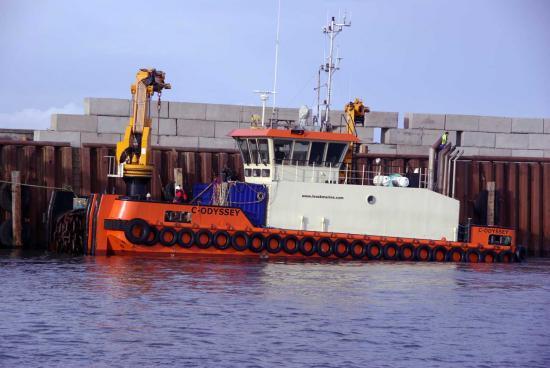
Report - Bill Mowatt
The flagship of the largest fleet of 'marine renewables support vessels' in Pentland Firth & Orkney Waters has been on a two-day operational working visit to Gills Harbour in Caithness.
The versatile C-Odyssey has been specifically designed to service the fledgling industry and was delivered new to owners/operators Leask Marine Ltd, of Kirkwall, Orkney Islands, from a shipyard in Rotterdam, Netherlands in 2011, at a reported cost of over Ł3 million.
The 26 metre-long 'Multiworker Twenty6', as she is technically classed, operated from the community-owned little port on the shores of the Pentland Firth's Inner Sound on February 7th & 8th, 2014.
The powerful many-purpose work-vessel is the flagship of Leask Marine Ltd's six-strong marine-renewables fleet. She is capable of being used as a tug, a heavy-lift vessel with a capability of hauling 120 tonnes over her bow, also for assisting in tidal-turbine installation and associated sub-sea cabling operations. She can be used as a general supply-boat as well as a 'steady' platform for operators of ROVs (remotely-operated underwater vehicles).
Her capabilities, often in challenging weather and sea conditions, have been amply demonstrated at the European Marine Energy Centre's (EMEC's) busy tidal test facility off the island of Eday and at its 'wave energy converter' test-site off Orkney Mainland's West coast, near Stromness.
For her early February 2014 visit to Gills Harbour, she had a team of four divers on board, for 'ADCP Recovery Diving Operations' in the Firth's Inner Sound, according to the 'Official Notice to Mariners' in the Pentland Firth.
Acoustic Doppler Current Profilers (ADCPs) are data-recording devices for accurately measuring the speed of tidal streams at various points in the water-column between the sea-floor and surface, while these also remotely measure wave-heights and directions, usually over a lengthy period of time to provide accurate year-round information.
C-Odyssey's 2014 debut visit comes as the directors of Canisbay community-owned Gills Harbour Ltd (GHL) step up efforts to provide all-tides, round-the-clock access for such vessels in shelter in a deepened Gills Harbour Inner Basin, by appointing a small team of specialist 'renewables' consultants as advisers and for fund-raising guidance.
Leask Marine Ltd's managing director, Kirkwall businessman Mr Douglas Leask has already told GHL that he fully supports the enhancement of facilities at Gills Harbour which he states 'is conveniently located for tidal-stream seabed lease sites in the Pentland Firth'. He was referring to the four large seafloor 'plots' so far licensed by the Crown Estate for tidal stream electricity generation.
Gills Harbour belongs to c. 600 electors in scattered crofting-origin settlements from West Mey to John O'Groats inclusive.
GHL, whose directors are all unremunerated, is chaired by Bill Mowat, of John O'Groats, Caithness, a former elected Councillor for NE Caithness, who is a Fellow of the Energy Institute (FEI).
The Scottish Mainland's most Northerly port lies at the inland apex of Gills Bay, half-a-mile 'inside' of the main twice-daily reversible tidal streams.
Its position is within 1 to 1.5 miles of MeyGen Ltd's Inner Sound seabed lease and no more than 8 miles from the Crown Estate's other three sites on the Pentland Firth's seafloor.
All of those lie under the narrowest Eastern end of the Pentland Firth, where the tidal streams flow most swiftly, and so offer the best opportunity of capturing of the 'kinetic energy' that these contain.
This will be by using recently-devised 'horizontal hydro-electricity' technology, being developed by a number of prominent international engineering companies, with some North of Scotland input.
Mr Mowat said: 'Obviously we were pleased to see the C-Odyssey back working in local waters from Gills.
'We at GHL believe that she and other broadly-similar powerful small vessels will play an important role in ensuring that Pentland Firth tidal-stream electricity starts to become a reality within the next couple of years.
'But the key to making certain that this becomes a long-term feature of the local economy, rather than a 'flash-in-the pan', is to ensure that its costs are on a steadily-reducing scale, so that tidal-stream electricity is showing clear signs of becoming competitive with other methods of 'renewables' generation by, say, 2020.
'Short, fuel-saving, sea supply-lines and avoidance of known Pentland Firth 'tidal race hazards' so as to provide as safe and comfortable working environments as possible for sea-going engineers, technicians and crews, will all be crucial to this end, as will a dredged Inner Basin here.
'We are pleased that C-Odyssey's owners are amongst the vessel-owning marine engineering professionals who share our view in GHL that an enhanced Gills Harbour will have an important role to play here'.
During 2013, Leask Marine Ltd's 23.3 metre 'multi-cat' C-Salvor and its survey vessel Ocean Explorer, a 'Procharter 40', both operated from Gills Harbour on Pentland Firth tidal-stream electricity contracts.
PHOTO
C-Odyssey at Gills Harbour by retired Harbour treasurer Billy Magee.
Related Businesses
Related Articles
Three Cats At Gills Harbour
Two catamaran work-boats berthed at Gills Harbour this week with the trans-Pentlnd ferry MV Alfred, also a catamaran, in the background. The larger workboat is MPC Athenia which was being used as a floating base or ROVs - remote underwater vessels, for detailed inspections on the three turbines operating at the MeyGen demonstration subsea site one and a half miles off Gills Harbour.
GILLS HARBOUR Ltd ANNUAL GENERAL MEETING
GILLS HARBOUR Ltd - ANNUAL GENERAL MEETING at JOHN O'GROATS VILLAGE HALL, MONDAY JUNE 13th @ 7.30 PM. GILLS HARBOUR IS THE ONLY OFFICIALLY-RECOGNISED 'ECONOMIC DEVELOPMENT AREA' IN NE CAITHNESS.Latest Boats At Gills Harbour For Work At Meygen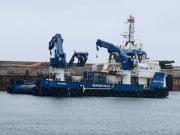
ÂŁ10 million 'Isle of Jura' temporarily based at Gills Harbour in Far North of Scotland for her crew's debut tasks in the tidal-stream electricity field at the MeyGen sub-sea site, one mile off the little Caithness's port entrance channel. One of the UK's most modern marine renewables service vessels made her debut calls at community-owned Gills Harbour, near John O'Groats, over the 2021 Spring Equinoctial weekend.
Busy Gills Harbour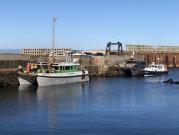
Its been a busy few days at local community-owned Gills Harbour ..... sometimes in suberb sunny weather as here ...
Energy Developments Continue at Gills Harbour and the Pentland Firth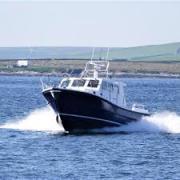
The company behind the world-leading tidal-stream prototype power plant in the Pentland Firth's Inner Sound is set to start manufacturing a new-style turbine that is hopes will reduce the project's generating costs. Simec Atlantis Energy (SAE) and a privately-owned specialist engineering firm from Spain's Bay of Biscay coastline have jointly been conducting 'research and development' (R& D) on the project for almost a year and are now ready to give it the go-ahead.
New Generation of office-bearers set to step up at Gills Harbour Ltd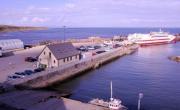
A new generation of younger local folk look set to take over the reins of running Gills Harbour Ltd, the local company that owns and operates the busy little port on the shores of the Pentland Firth's Inner Sound that holds its AGM this Saturday (10.10.20) morning at 10:00 am. The influx of younger blood comes after two key directors of the group that had run 'Canisbay's Peoples Port' both announced their retirement from office, whilst another Gills Harbour Ltd (GHL) office-bearer has declined to seek re-election.
MV Alfred And MV Pentalina Together At Gills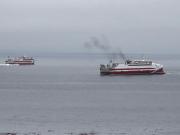
An 'old friend' returns to Gills Bay after an absence of manymonths. The 2,400 tonne 70 m.
Normand Cutter, The Norwegian-owned Offshore Construction Vessel at Gills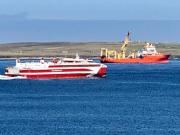
Here is the Normand Cutter, the Norwegian-owned offshore construction vessel that has been the base for works on Simec Atlantis Energy's (SAE's) MeyGen site in the Pentland Firth's Inner Sound, off Gills Bay during the current neap-tide sequence, that has lasted most of the week commencing 11.08.20. Picture by retired C of S Kirk Minister the Rev Lyall Rennie, who lives at Lower Warse, Canisbay, on the shores of Gills Bay..
New Ferry For Pentland Ferries Arrives Safely
Scotland's most modern + environmentally-friendly, fuel-efficient ROPAX ferry ship rge MV Alfred, arrived AM today (Wed 09.10.19 at St Margarets Hope. The boat went round to Kirkwall immediately at the end of 9,000+ miles voyage from the Strategic Marine yard near Ho Chi Minh city (ex.
Gills Harbour Ltd Awards Contract To Local Firm
Gills Harbour Ltd, the community-owned body that owns & operates the busy little port on Caithness's North Coast, has awarded a remedial contract to a Wick-based company. The deal, won in a competitive tender, has gone to builders/civil engineers Messrs GMR Henderson Ltd, of Martha Terrace in Wick.
